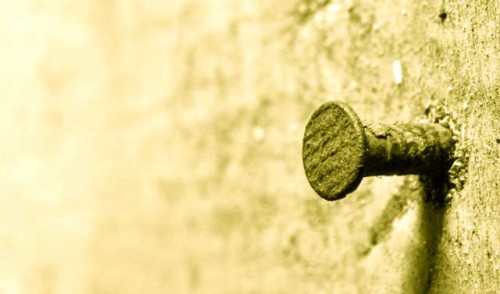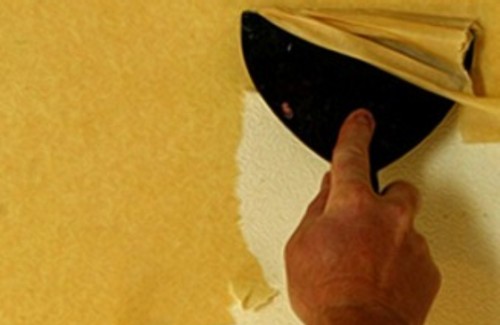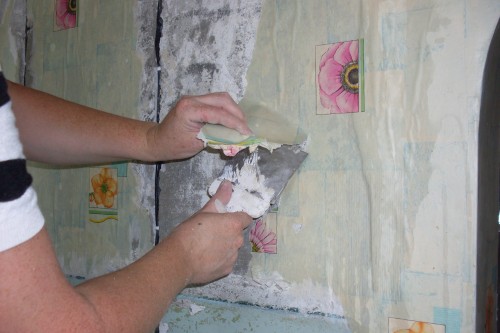Overflow of wallpaper is the fastest and most economical way to completely change the face of the room. With their help, you can quickly turn a boring room into an elegant girlish bedroom or a strict office.
Content
The modern market offers a breathtaking choice of all kinds of wallpaper for any purpose. And so you bought the treasured rolls and want to quickly transform your home, but what about the old wallpaper? Remove or glue on top? You certainly need to get rid of the old wallpaper, and in this article we will tell you how to remove old wallpapers as quickly and easily as possible.
Preparatory work
Before tearing off old wallpapers, it is necessary to carry out some preparatory work that will significantly facilitate the process.
Cleaning the room
Removing old wallpapers is a rather dusty and “garbage” procedure, so before starting repair work, take out all the furniture from the room, turn the carpets and remove everything that can be dirty - decorative interior items, equipment, flowers, etc.
If the floor is placed by linoleum, after removing the old wallpaper it will be easy to wash. But in the case of parquet or carpet, problems may arise. Therefore, fading the floor under the walls with oilcloth or old rag. The width of the coating should be at least 1 meter. In the process of removing the wallpaper, all the dust and small particles of the wallpaper will fall on it, so after the completion of the work you will only have to shake out the SOR, avoiding capital cleaning.
Removing fasteners
When the furniture is carried out, and the floor is covered with oilcloth, carefully inspect the walls. Surely in the room there were paintings or panels, shelves or decorative attributes hung. It is necessary to examine each site and remove all nails, screws and other fasteners. Firstly, an accidentally missed clove can ruin the appearance of future wallpaper. Secondly, you can greatly damage your hands, scratching on the sharp edge of the nail. Therefore, it is better to play it safe and dismantle everything that can bring problems from the wall.
Removing old wallpaper
Removing old wallpapers from the walls is quite easy if you know some nuances. Thus, the strategy of your actions should depend on the type of wallpaper. For example, in the days of the USSR, before covering the wall with wallpaper, it was glued with a newspaper, they say, it would be better to hold on. Undoubtedly, in some apartments, such wallpapers are “alive” to this day. But what if the interior fashion of the last century has already bored, but to tear off old wallpaper, tightly glued to the newspaper layer, does not work? Below we will consider how to remove various wallpaper.
Paper wallpaper
Old paper wallpapers should be taken by "great". Methodically moisten the surface with warm water with a sponge or from a spray gun. If you have unscrupulous owners who have pushed the wallpaper over the old ones, you will have to remove the coating in layers - there is nothing to be done here.
In order to remove old wallpapers from the walls as easily and quickly as possible, start from below, pissing the lower edge of the coating with a knife or spatula. Gently pull a piece of wallpaper up, if necessary, helping it to peel off the wall.
The remaining pieces of wallpaper also need to be removed. It requires special accuracy, because if you damage the wall, you will have to plaster holes and bumps.
Moisture -resistant wallpaper
If you are lucky to deal with moisture -resistant wallpaper, you won’t go against simple water against them - the water will simply slide down the hydrophobic layer on the floor. Knowledge of the structure of wallpaper will help here. Typically, water -repellent wallpaper multi -layered, and by removing the upper protective layer, you can get to ordinary paper, which, as is already known, is removed using water.
If the water -repellent wallpaper is solidly glued, then it is not necessary to remove the lower paper layer - it will become an excellent basis for gluing new wallpapers, providing excellent adhesion. If you still decide to completely remove, remove the water-repellent layer, gently picking up the wallpaper with a spatula and stretching down from the bottom up. Remove the remaining paper coating with a damp sponge and clean it with a spatula.
Floselywain wallpaper
But in some cases, moisture -resistant wallpapers do not behave so well and are not relaxed. In such a situation, you will have to tinker pretty, cleaning the upper protective layer with a spatula. The non -woven wallpaper is only removed, but there are a couple of tricks that will facilitate your task.
If the area is small, use a hard metal brush (construction or for washing dishes). If you have to clean a large room, it is better to use a power tool, such as Ushm with a metal brush. But here everything is not as smooth as we would like - the upper layer is made of synthetic materials and quickly clogs the apparatus brush, so it will have to be cleaned quite often. However, perfectionism is useless here, and in order to remove non -woven wallpaper, you just need to scratch the surface well, and not clean the wallpaper completely. After that - water, a spatula and already familiar manipulations.
How to remove old wallpapers from the walls pasted on waterpolimal glue glue
Glue the wallpaper on the watering glue, or simply PVA, is probably the most unsuccessful idea. And by “happy chance” in generous Soviet times, such builders often came across that glued wallpaper then popular with Bustilat. Why is PVA not suitable for wrapping wallpaper, because he really holds well? That is the problem - he holds too well. After solidification, the water -polymer glue is not amenable to soaking and dissolving with water, so it will be very difficult to remove such wallpapers.
If you are faced with wallpaper glued to PVA, you should seriously think about other methods of wall decoration. Remove the old wallpaper without damaging the surface of the wall, you will not succeed. Of course, you can spend money on plaster and glue new wallpaper, but it is worth considering less time -consuming options. For example, sheathe the wall with drywall, which will save a lot of effort, time, and will give a better result. Gypsumwarton insulation of the wall, will ensure sound insulation and will allow any repairs, starting from gluing new wallpaper to artistic mosaic.
But back to the removal of the wallpaper glued to the PVA. It will not work to soak them, no matter how you try, so be patient and tools. Literally a centimeter by a centimeter with a sharpened spatula or scraper will have to be removed. If possible, use the referral of a milling mill, which is designed specifically to clean the pasted or painted surfaces.
How to peel off old wallpaper from drywall
The difficulty of working with drywall is that during the removal of wallpaper, a paper layer on the surface of the material may suffer. For this reason, ordinary water can not do here. Use special products to dissolve wallpaper glue, which can be found in specialized construction stores. You can moisten water with water, but not abundantly - so as not to soak drywall. If the wallpaper is glued to PVA, drywall will have to be completely changed.
Useful trick: Once someone tried to remove old wallpapers instead of water to use hot steam, and it turned out! Moving the “difficult” places with an iron with a steaming function or a steam generator, and the wallpaper will quickly peel off.
Why should not glue wallpaper on old wallpaper
If it seems to you that sticking new wallpaper on the old ones is a good idea that will save time and effort, we recommend that you think about the consequences for a second. What are wallpaper? This is a coating that has been in contact with things, human skin (then, mud) for several years, absorbed various smells, microbes during diseases ... Now imagine that such a dirty harmful layer will be under your beautiful new wallpaper, and after all, after all New wallpapers will become the same over time. Old wallpapers increase humidity in the room and can provoke infection with fungi and mold.
Removing wallpaper is inevitable, so reconcile with this and use one of the above methods. Easy repair!














